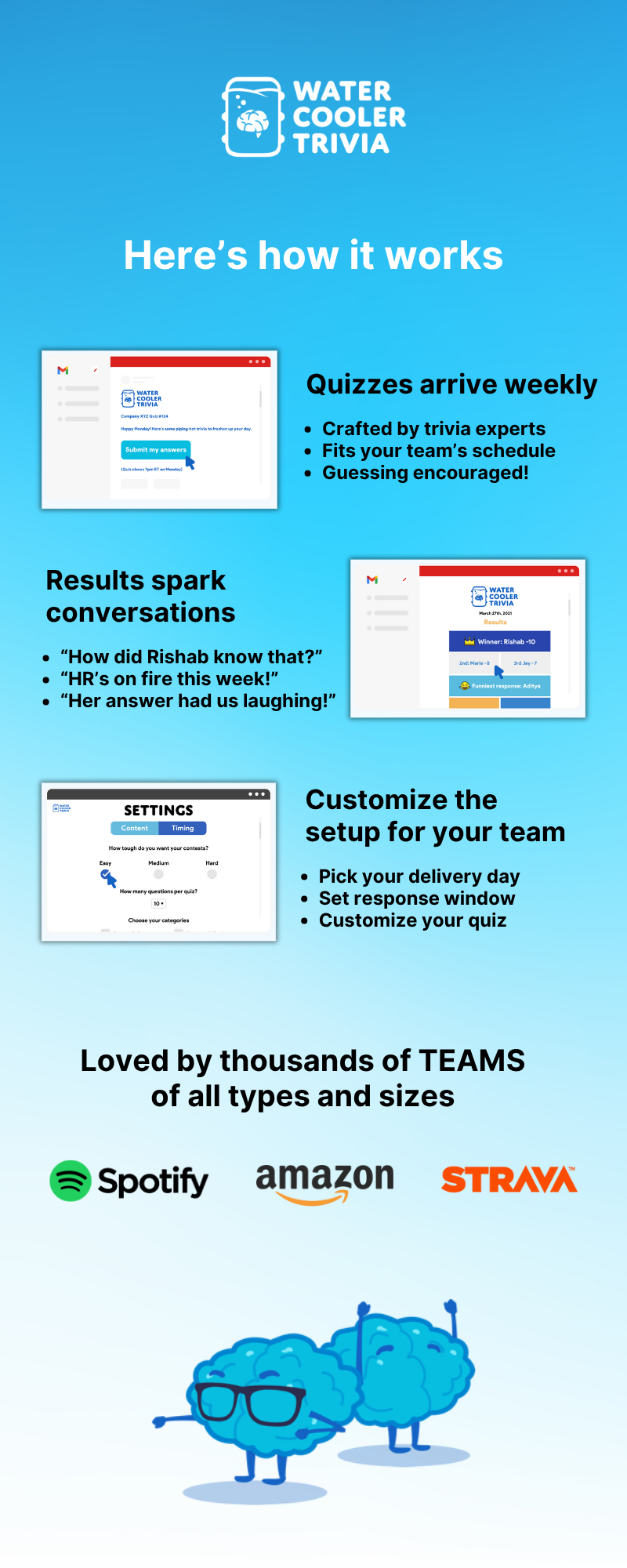%20(1).png)
Good team meeting ideas are hard to come by.
I’m often chatting with team leaders who want to try Water Cooler Trivia as a fresh way to bring some fun and connection to their weekly team syncs.
Most have already cycled through many different meeting formats, but nothing’s really stuck.
After dozens of these conversations, I’ve pulled together the meeting formats that actually work in 2026, the games you can skip for good, and one idea that keeps teams awake, laughing, and actually looking forward to Mondays.
Before I get into what I see working in 2026, I think it’s useful to know what you should avoid.
Here are my seven deadly sins of team meetings:
With each meeting, you have a massive opportunity to strengthen bonds between team members. Ultimately, it comes down to execution.
I’ll narrow things down for you.
If your meetings open with tired updates, I want you to replace them with trivia.
Even the most established teams can get a little frosty on Monday mornings. Water Cooler Trivia melts that chill fast!
It’s quick, easy, and actually fun. In under 10 minutes, it breaks the ice and sets a tone where team members actually want to talk to each other.
Every team has that one person who dominates the conversation and another who barely speaks.
What we’ve found is that trivia balances that dynamic.

The trivia questions give team members something light to react to before diving into business.
You can choose between email, Slack, or Teams delivery. Team members answer before the meeting or live together on screen.
Managers use Water Cooler Trivia as a “meeting warm-up” instead of another icebreaker. It gets people laughing and thinking together.
It won't hijack your agenda or turn into a competition you regret scheduling altogether.
This is just a light starter that’ll generate some inside jokes and break any unnecessary tension between employees.
I think that’s a solid return on just 10 minutes of your team’s time.
If you want a meeting format that consistently delivers energy, I want you to make trivia your ritual. You can try it free for four weeks.
Here are the practical formats I recommend for the year ahead.
Start each meeting with a quick trivia quiz. Pick the theme and we’ll handle the questions.
Everyone gets 30 seconds to share one win or one challenge. You can keep a timer visible to keep things moving and focused.
Before the meeting, everyone reads a short agenda document. Spend the first five minutes adding comments silently, then discuss only the key points that stand out.
Once a month, ask teammates to share something cool from their week. This might be a new tool, a meme, or a clever project hack.
You can rotate who runs the meeting each week. The host gets to choose their own format, which keeps things fresh and unpredictable.
Take five minutes to highlight a customer success or even a challenge. It keeps the focus on real-world impact.
I would post a lighthearted question in Slack before the meeting, like “Which snack best represents our team?” Read out the results at the start.
Give someone the floor to vent about something harmless like bad fonts, loud keyboards, or weird Slack threads. It’ll prove to be surprisingly cathartic.
You can pose a fun question like “Should coffee breaks be mandatory?” Two volunteers argue for 60 seconds each, and everyone votes on the winner! What could possibly go wrong?
Add one team song each week and play it quietly while people join the call. Music sets a better tone than small talk.
Skip the text-heavy slides. Start with a single image or simple diagram that sums up what you’re discussing.
Have everyone share one win and one thing they learned that week. It keeps the team open and grounded.
You can invite someone from another department to give a quick update on what they’ve been working on. It helps everyone stay connected.
I like to collect anonymous questions during the week and start the meeting by answering one or two.
Use a virtual wheel with prompts like “New Product Ideas” or “How to Save Time.” Everyone adds ideas for five minutes, no judgment.
Ask everyone to describe how they’re feeling with emojis or weather terms. It’s a simple, honest way to gauge team energy.
You can let each speaker use just one slide. It adds some useful constraints to the meeting and keeps people from rambling.
Why not create a shared thread or board for team memes? Review the best ones in the meeting. It’s a guaranteed mood boost. I’ve seen it work every time.
Give everyone two minutes to type their ideas into a shared doc without talking. Then discuss only the strongest ones together.
Tell the team that if all goals are met by the forty-minute mark, everyone gets the last 20 minutes back. It’s amazing how motivating this can be.
It’s a serious question.
Teams that rotate these formats see higher attendance and fewer cameras turned off.
We’ve noticed that the most successful teams schedule recurring trivia at least once a week.
It’s light enough to refresh and structured enough to maintain rhythm.
We’re not talking about reinventing the wheel here.
People stay engaged when they know what to expect but still get a small twist each week.
I’m talking about the element of surprise!
Use Water Cooler Trivia with your free four-week trial. Add a few ideas from the list. Keep it light and consistent.